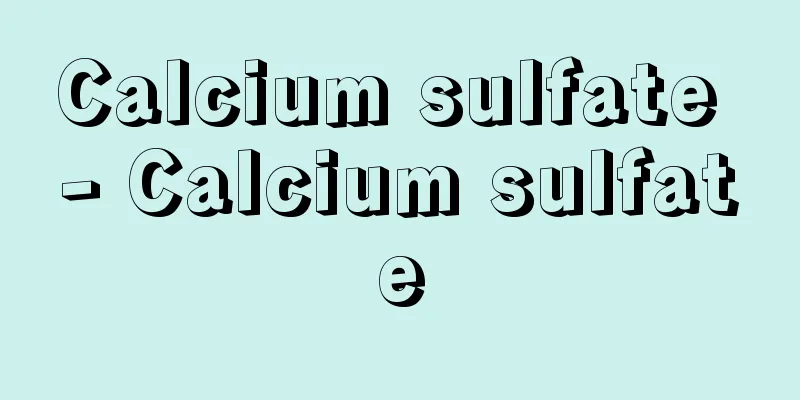Calcium sulfate - Calcium sulfate

|
Calcium sulfate. Chemical formula: CaSO 4 , formula weight: 136.1. Naturally, it is found in large quantities as dihydrate (gypsum) and anhydrate (anhydrite) deposits, as well as in rock salt deposits, seawater, and hard water. Industrially, it is extracted from natural products, and is also produced as a by-product in various chemical industries. When dilute sulfuric acid or an aqueous solution of an alkali metal sulfate is added to an aqueous solution of calcium salts, the dihydrate precipitates at temperatures below 66°C, and the anhydrate precipitates at temperatures above 66°C. Both are colorless, but natural anhydrates are colored due to the presence of impurities. Generally, it is not very soluble in water; for example, the solubility of the anhydrate at 20°C is about 0.3 grams per 100 grams of water. When the dihydrate is heated to about 100°C, it turns into 0.5-hydrate (orthorhombic crystal system, specific gravity 2.63, also known as gypsum or hemihydrate), but it actually contains a small amount of anhydrate. This mixture is calcined gypsum, which absorbs water at room temperature and returns to the dihydrate. When this happens, heat is generated and the volume increases. If the dihydrate is heated above 200°C for a long period of time, it becomes an anhydrate, which does not return to the dihydrate even when water is added. A soluble anhydrate (triclinic crystal system, specific gravity 2.45) can be obtained by heating below 200°C in air, or by dehydrating with diphosphorus pentoxide at 60-90°C under reduced pressure. It has an extremely wide range of uses as gypsum and calcined gypsum. [Torii Yasuo] [Reference] | |Source: Shogakukan Encyclopedia Nipponica About Encyclopedia Nipponica Information | Legend |
|
硫酸のカルシウム塩。化学式CaSO4、式量136.1。天然に二水和物(石膏(せっこう))および無水和物(硬(こう)石膏)の鉱床となって大量に産出するほか、岩塩鉱床、海水および硬水に含まれる。工業的には天然物の採取のほか、種々の化学工業で副産物として製造される。カルシウム塩の水溶液に希硫酸、またはアルカリ金属の硫酸塩の水溶液を加えると、66℃以下で二水和物、それ以上では無水和物が析出する。いずれも無色であるが、天然の無水和物は不純物の混入で着色している。一般に水にあまり溶けず、たとえば無水和物の20℃での溶解度は水100グラムに対し約0.3グラムである。二水和物は100℃程度で加熱すると0.5水和物(斜方晶系、比重2.63。焼き石膏、半水石膏ともいう)に変わるが、実際には少量の無水和物を含んでいる。この混合物が焼石膏(しょうせっこう)で、常温で水分を吸収して二水和物に戻る。その際、発熱して体積が増す。二水和物を200℃以上で長時間加熱すると無水和物となるが、これは水を加えてもほとんど二水和物に戻らない。なお空気中200℃以下での加熱、あるいは減圧下60~90℃での五酸化二リンによる脱水によって、可溶性の無水和物(三斜晶系、比重2.45)が得られる。石膏、焼石膏としてきわめて広い用途がある。 [鳥居泰男] [参照項目] | |出典 小学館 日本大百科全書(ニッポニカ)日本大百科全書(ニッポニカ)について 情報 | 凡例 |
<<: Silver Sulfate - Silver Sulfate
Recommend
Rotational motion - Rotational motion
The motion of a mass or a set of masses, or a spe...
Proletarian literature - Proletarian literature
This refers to literature based on the class cons...
Kagome Kagome
〘Noun〙 ("Kagome" may come from the imper...
Blackcurrant - Cabbage
Scientific name: Cayratia japonica Plants. Perenni...
"Kamiyui Shinza"
...By Kawatake Mokuami. Commonly known as "K...
Hügel, Friedrich von
[Born] 1852 [Died] 1925 English Catholic theologia...
《Khozhdenie po mukam》 (English notation) Khozhdenie pomukam
…After returning to the Soviet Union in 1923, he ...
London Bridge - Londonbashi
A bridge over the River Thames in London. It is a ...
baile flamenco (English spelling) baileflamenco
...There are many other notable folk dances, but ...
Left side - Saho
〘 noun 〙① The left side. ⇔ The right side. ※From E...
Nitrogen Sulfide - Leucathio
A general term for compounds consisting of S and ...
Storm petrel - Storm petrel
A general term for birds in the Hydrobatidae famil...
Induced insanity; communicated insanity
A mental illness that occurs in a person who is in...
The Epistle of James - The Epistle of James
This is one of the letters known as the "Publ...
Kijiyama
...Today, the main industry is agriculture, with ...









